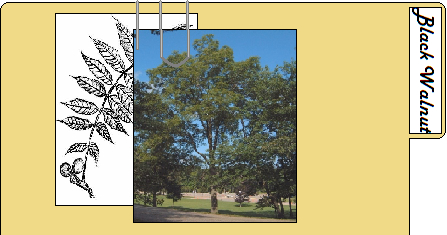Scientific Name Juglans nigraCommon Name Black Walnut
Type Deciduous
Growth Rate Moderate
DistributionGeography Central/Eastern portion of the United States
Location Along streams, on the slopes adjacent to the floodplains and in rich woodlands
Soil Deep, rich, well-drained
Zones Zone 4, Zone 5, Zone 6, Zone 7, Zone 8
General StatsHeight up to 150 feet
Diameter 2-5 feet
Trunk Straight
Crown Rounded
Visual FeaturesBark Black, thick, and deeply grooved
Twigs Stout, smooth, and greenish brown or gray
Buds Whitish, woolly, more or less rounded at the tip, and up to 1/2 inch long
Leaves Large (12 - 24 inches long), alternate, and pinnately compound with 17 - 25 lanceolate leaflets. The leaflets are toothed at the edges, pointed at the tip, and up to 3 1/3 inches long and 1 1/2 inches broad. The base of the leaflet is asymmetrical. Leaflets are yellowish green and smooth on the surface, paler and slightly hairy underneath, especially along the veins
Flowers Monoecious, with separate male and female flowers occurring on the same tree. Flowers appear in April - June. The female flowers (pistillate) are without petals occur a few clustered together in small spikes. They are relatively inconspicuous. The male flowers (staminate flowers) occur as several together in hairy catkins that are greenish yellow
Fruits Singly or in pairs. They are spherical, up to 2 inches in diameter, with a thick, warty husk that is entire (unlike the black hickory, in which the husk is split into four sections when the fruit is ripe). The nut husk is very hard and the seed wonderfully sweet (The walnut grown commercially in California is
Juglans regia. Native black walnut is also very tasty - particularly when made into a paste and eaten on a sandwich with honey, as one would peanut butter). The seeds (nuts) have prominent longitudinal grooves and are warty and dark brown. They ripen in October - November.
Warning: The residue on the husk protecting the walnuts stains and is a b***h to get off!Uses Black walnut wood is one of the most desirable for cabinets, veneers, furniture, and interior finishing. It is hard, heavy, coarse grained, very attractive, and easy to work with. It is also used for gunstocks. The bark is used for tanning and the nut husks have been used as a toxin for fish (currently illegal), and for yellow-brown dyes. The nuts are a food source for humans, squirrels, mice, and other wildlife. The twigs are browsed by deer. Native Americans used black walnut medicinally to treat skin disorders and as a psychological aid.
Interesting Facts Black walnut is a highly prized and beautiful tree, and large specimens have been nearly eliminated (harvested) in some parts of the country. They are scattered throughout mesic forests and occasionally occur in small, pure stands only at the periphery of these forests. Black walnut leaves, bark, nut husks, and roots contain "juglone," a chemical that is lethal to and prevents the growth of many other plants within the tree's rooting zone. Paper birch, red pine, white pine, Scotch pine, and apple are reportedly sensitive to this toxin. Tomatoes are especially affected by the substance and will not grow near large black walnut trees. Bruised nut husks were formerly used to kill fish for consumption until the practice was made illegal.
Gets Along With Most species of the eastern oaks, the ashes, yellow poplar, beech, sugar and silver maple, basswood, river birch, most hickory species, sugarberry, black cherry, cottonwood, the elms, black gum, sweet gum, and to a lesser extent, many smaller trees and shrubs
Does Not Get Along With Tomatoes, potatoes, alfalfa, blackberry, domestic grape, lilac, hydrangea, chrysanthemum, paper birch, red (Norway) pine, Scotch pine, hackberry, apple
Growing/Caring For a Black Walnut Begin controlling weeds, grasses, and brush before planting and continue at least three years after planting. The longer competing vegetation is controlled, the better the walnuts will grow. Leave crop stubble for moisture retention, weed suppression, and erosion control. Remove excess stubble that will interfere with machine planting of walnuts. Chisel-plow the planting site if there is a plow pan, or disk to loosen compacted soil. Sod strongly competes with walnut trees. Mowing will not adequately control grass. Before planting, remove sod in strips or patches by rototilling, disking, or using herbicides. Clear at least a 7- to 12-square-foot area around each planting spot (1 to 2-foot radius around each seedling). Continue cultivation, chemicals, or mulch to maintain sod-free conditions around individual trees for at least three years or until tree crown closure occurs. If you cultivate, keep rototillers and disks away from tree stems and till no more than 6 inches deep. Where chemicals are used, always read and follow label directions. Preemergent chemicals are less likely to damage walnut seedlings than foliar applied chemicals. Keep mulches 1 to 2 inches away from tree stems to avoid heat buildup. Wood chips, sawdust, bark, shredded corn cobs, plastic sheets, or fabric weed barrier mats can be used. Because organic mulches use nitrogen when they decompose, you may need to add nitrogen fertilizer around trees to maintain vigorous growth. Yellowish walnut leaves during the growing season may indicate a nutrient deficiency. Some mulches may attract small rodents that build nests and then feed on tree seedlings in fall and winter. Be very cautious when using herbicides where walnut trees grow or will be planted. Walnuts are easily damaged when some herbicides are applied nearby and drift through the air or wash onto the ground where walnuts can absorb them. Mulches can be used instead of herbicides to control grasses and broad-leaved weeds around walnut seedlings. However, they will not suppress sprouting from woody plants and are difficult to apply in wooded environments. Mark each seedling with a wire flag or ribbon to help you relocate it for follow-up weed control.
RecipeBlack Walnut & Wild Rice Elegante ~ an elegant rice pilaf to add a touch of class to your meal1 cup uncooked Wild Rice
1/4 cup butter
1 cup sliced mushrooms
1/2 cup chopped green pepper
1 teaspoon garlic salt
1/2 cup Black Walnuts
Cook the wild rice according to basic directions. Melt the butter and saute he Black Walnuts, mushrooms, onion and green pepper about 3 minutes, or until the vegetables soften slightly. Add the wild rice and garlic salt and continue cooking, stirring several times, until wild rice is heated through. Serves 4 to 6
Information Sourceshttp://www.museum.state.il.us/muslink/forest/htmls/trees/J-nigra.html
http://greenwoodnursery.com/page.cfm/340
http://www.walnutcouncil.org/botanical_description.htm
http://www.extension.umn.edu/distribution/naturalresources/DD0505.html
Picture Sourceshttp://www.wildmanstevebrill.com/Plants.Folder/BlackWalnut.html
http://bio.bd.psu.edu/plant_web/Juglandaceae/Black_Walnut_Plant.html
Recipe Sourcehttp://www.thenutfactory.com/kitchen/main-dish/walnut-wild-rice-pilaf.html






 Name: Krys "Elf" Ricci
Name: Krys "Elf" Ricci
